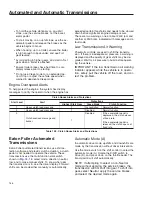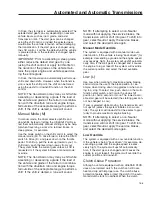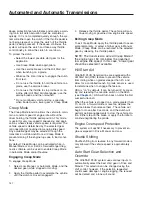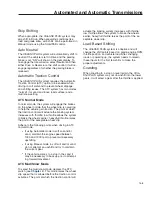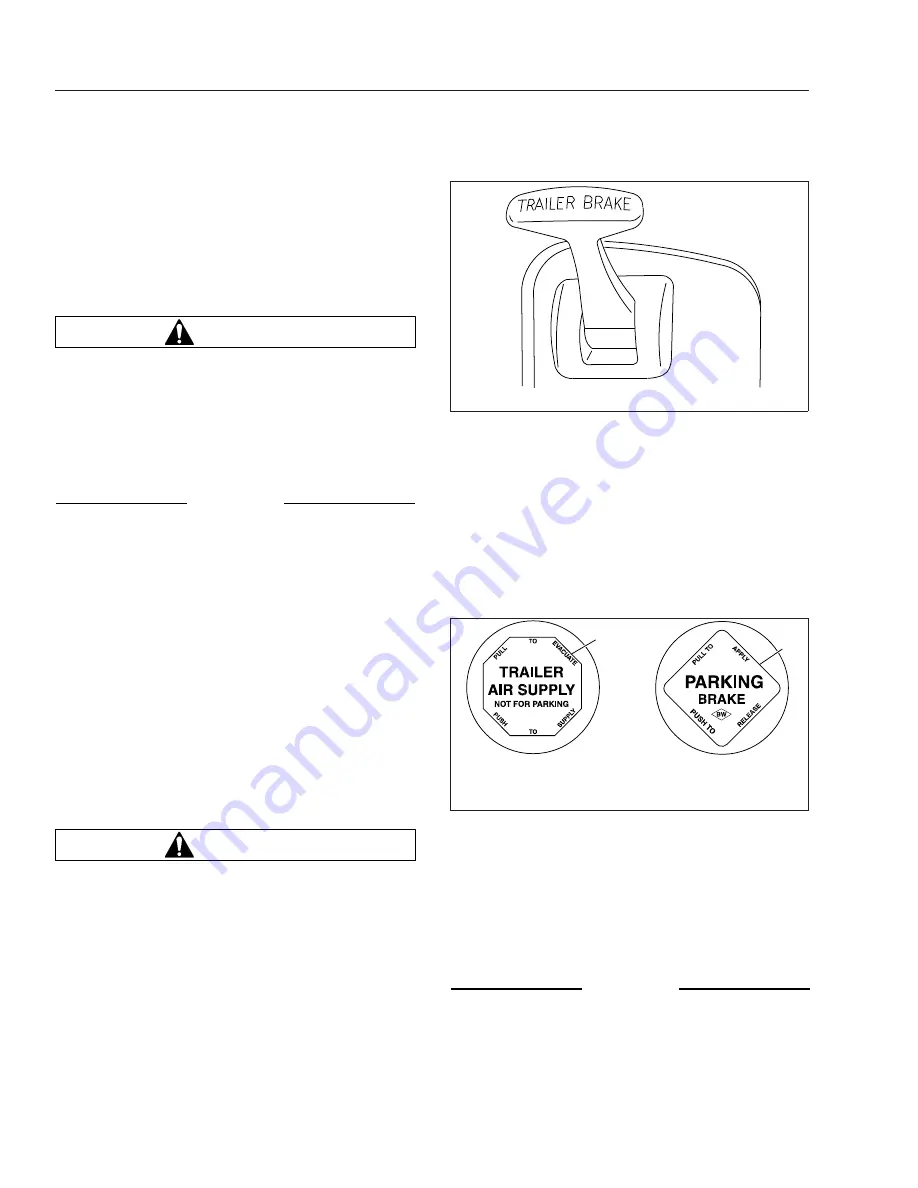
bobtail mode. When the tractor is towing a
trailer, the rear brake chambers will receive full
(normal) application air pressure.
When parking a vehicle attached to a trailer that
does not have spring parking brakes, apply the trac-
tor parking brakes. Chock the trailer tires before dis-
connecting the vehicle from the trailer.
WARNING
If a trailer or combination vehicle is not equipped
with spring parking brakes, do not park it by pull-
ing out only the trailer air supply valve knob.
This would apply only the trailer service brakes.
If air were to bleed from the trailer brake system,
the trailer brakes would release, possibly causing
an unattended runaway vehicle.
NOTICE
Never apply the service and spring parking
brakes simultaneously. To do so transmits exces-
sive input force to the brake components, which
could damage or cause eventual failure of brake
actuating components.
Brake Controls
The trailer brake lever (hand control valve) is used
for applying the trailer brakes without applying the
truck or tractor service brakes. It is usually mounted
on the right-hand control panel. See
. The
valve can be partially or fully applied, but in any par-
tially on position it will be overridden by a full applica-
tion of the service brake pedal. Moving the lever
down applies the trailer brakes, while moving it up
releases the trailer brakes. The lever will automati-
cally return to the up position when it is released.
WARNING
Do not use the trailer service brakes for parking;
they are not designed for this purpose. If air
bleeds out of the trailer air tank during parking,
the vehicle could roll, causing serious personal
injury or property damage.
The red octagonal-shaped knob in the control panel
actuates the trailer air supply valve. See
After the vehicle’s air hoses are connected to a
trailer and the pressure in both air systems is at least
65 psi (448 kPa), the trailer air supply valve must be
pushed in. It should stay in to charge the trailer air
supply system and to release the trailer spring park-
ing brakes.
Pull the trailer air supply valve out before disconnect-
ing a trailer or when operating a vehicle without a
trailer. If pressure in both air systems drops to 35 to
45 psi (242 to 310 kPa), the trailer air supply valve
automatically pops out, exhausting the trailer air sup-
ply, and applying the trailer service or spring parking
brakes.
The yellow diamond-shaped knob in the control
panel actuates the parking brake valve. See
. Pulling out the parking brake valve applies
both the tractor and trailer spring parking brakes and
automatically causes the trailer air supply valve to
pop out. Pushing in the parking brake valve releases
the tractor parking brakes.
NOTICE
Do not use the spring parking brakes if the ser-
vice brakes are hot, such as after descending a
steep grade. To do so could damage the brakes.
f610591
02/03/2017
Fig. 13.1, Trailer Brake Lever
f610291
02/02/2017
1
2
1.
Trailer Air-Supply-Valve Knob
2.
Parking-Brake-Valve Knob
Fig. 13.2, Brake Valve Knobs
Brake Systems
13.3
Summary of Contents for NEW CASCADIA 2016
Page 1: ... NEW CASCADIA Driver s Manual Part Number STI 500 Publication Number STI 500 8 ...
Page 5: ......
Page 11: ......
Page 38: ...f611444 10 31 2016 Fig 3 23 Sample Alert Messages Instruments 3 20 ...
Page 39: ......
Page 93: ......
Page 94: ...8 Cab and Sleeper Features Windows 8 1 Mirrors 8 1 Cab Amenities 8 1 Sleeper Amenities 8 2 ...
Page 99: ......
Page 125: ......
Page 134: ...14 Steering System Power Steering System 14 1 ...
Page 145: ......
Page 146: ...16 Manual Transmissions and Clutch Eaton Fuller Manual Transmissions 16 1 Clutch 16 1 ...
Page 149: ......
Page 150: ...17 Drive Axles Interaxle Lock Tandem Axles 17 1 Driver Controlled Differential Lock DCDL 17 2 ...
Page 164: ...19 Trailer Couplings Holland Trailer Coupling 19 1 ...
Page 177: ......
Page 191: ......
Page 198: ...25 Specifications Fluids and Lubricants 25 1 ...



























